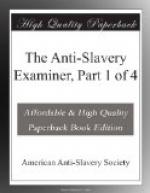MANSTEALING—EXAMINATION OF EX. XXI. 16.
The giving of the law at Sinai, immediately preceded the promulgation of that body of laws called the “Mosaic system.” Over the gateway of that system, fearful words were written by the finger of God—“HE THAT STEALETH A MAN AND SELLETH HIM, OR IF HE BE FOUND IN HIS HAND, HE SHALL SURELY BE PUT TO DEATH[A].” Ex. xxi. 16.
[Footnote A: A writer in the American Quarterly Review, commenting on this passage, thus blasphemes. “On this passage an impression has gone abroad that slave-owners are necessarily menstealers; how hastily, any one will perceive who consults the passage in its connection. Being found in the chapter which authorizes this species of property among the Hebrews, it must of course relate to its full protection from the danger of being enticed away from its rightful owner."—Am. Quart. Review for June, 1833. Article “Negro slavery.”]
The oppression of the Israelites in Egypt, and the wonders wrought for their deliverance, proclaim the reason for such a law at such a time. They had just been emancipated. The tragedies of their house of bondage were the realities of yesterday, and peopled their memories with thronging horrors. They had just witnessed God’s testimony against oppression in the plagues of Egypt—the burning blains on man and beast; the dust quickened into loathsome life, and swarming upon every living thing; the streets, the palaces, the temples, and every house heaped up with the carcases of things abhorred; the kneading troughs and ovens, the secret chambers and the couches, reeking and dissolving with the putrid death; the pestilence walking in darkness at noonday, the devouring locusts, and hail mingled with fire, the first-born death-struck, and the waters blood; and last of all, that dread high hand and stretched-out arm, that whelmed the monarch and his hosts, and strewed their corpses on the sea. All this their eyes had looked upon; earth’s proudest city, wasted and thunder-scarred, lying in desolation, and the doom of oppressors traced on her ruins in the hand-writing of God, glaring in letters of fire mingled with blood—a blackened monument of wrath to the uttermost against the stealers of men. No wonder that God, in a code of laws prepared for such a people at such a time, should uprear on its foreground a blazing beacon to flash terror on slaveholders. “He that stealeth a man and selleth him, or if he be found in his hand, he shall surely be put to death." Ex. xxi. 16. Deut. xxiv, 7[A]. God’s cherubim and flaming sword guarding the entrance to the Mosaic system!




